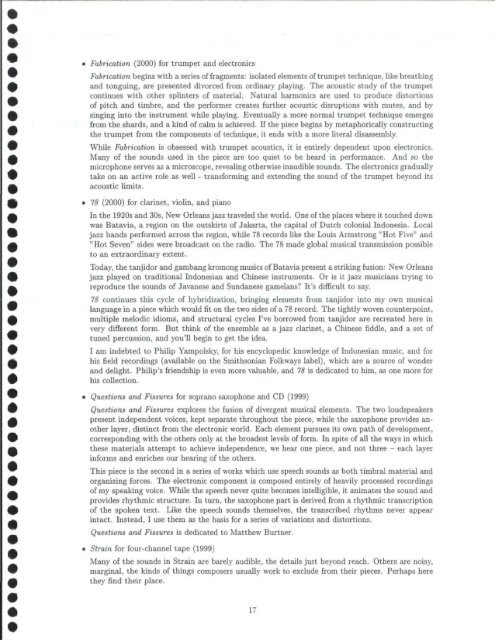CCRMA OVERVIEW - CCRMA - Stanford University
CCRMA OVERVIEW - CCRMA - Stanford University
CCRMA OVERVIEW - CCRMA - Stanford University
Create successful ePaper yourself
Turn your PDF publications into a flip-book with our unique Google optimized e-Paper software.
• Fabrication (2000) for trumpet and electronics<br />
Fabrication begins with a series of fragments: isolated elements of trumpet technique, like breathing<br />
and tonguing, are presented divorced from ordinary playing. The acoustic study of the trumpet<br />
continues with other splinters of material. Natural harmonics are used to produce distortions<br />
of pitch and timbre, and the performer creates further acoustic disruptions with mutes, and by<br />
singing into the instrument while playing. Eventually a more normal trumpet technique emerges<br />
from the shards, and a kind of calm is achieved. If the piece begins by metaphorically constructing<br />
the trumpet from the components of technique, it ends with a more literal disassembly.<br />
While Fabrication is obsessed with trumpet acoustics, it is entirely dependent upon electronics.<br />
Many of the sounds used in the piece are too quiet to be heard in performance. And so the<br />
microphone serves as a microscope, revealing otherwise inaudible sounds. The electronics gradually<br />
take on an active role as well - transforming and extending the sound of the trumpet beyond its<br />
acoustic limits.<br />
• 78 (2000) for clarinet, violin, and piano<br />
In the 1920s and 30s, New Orleans jazz traveled the world. One of the places where it touched down<br />
was Batavia, a region on the outskirts of Jakarta, the capital of Dutch colonial Indonesia. Local<br />
jazz bands performed across the region, while 78 records Uke the Louis Armstrong "Hot Five" and<br />
"Hot Seven" sides were broadcast on the radio. The 78 made global musical transmission possible<br />
to an extraordinary extent.<br />
Today, the tanjidor and gambang kromong musics of Batavia present a striking fusion: New Orleans<br />
jazz played on traditional Indonesian and Chinese instruments. Or is it jazz musicians trying to<br />
reproduce the sounds of Javanese and Sundanese gamelans? It's difficult to say.<br />
78 continues this cycle of hybridization, bringing elements from tanjidor into my own musical<br />
language in a piece which would fit on the two sides of a 78 record. The tightly woven counterpoint,<br />
multiple melodic idioms, and structural cycles I've borrowed from tanjidor are recreated here in<br />
very different form. But think of the ensemble as a jazz clarinet, a Chinese fiddle, and a set of<br />
tuned percussion, and you'll begin to get the idea.<br />
I am indebted to Philip Yampolsky, for his encyclopedic knowledge of Indonesian music, and for<br />
his field recordings (available on the Smithsonian Folkways label), which are a source of wonder<br />
and delight. Philip's friendship is even more valuable, and 78 is dedicated to him, as one more for<br />
his collection.<br />
• Questions and Fissures for soprano saxophone and CD (1999)<br />
Questions and Fissures explores the fusion of divergent musical elements. The two loudspeakers<br />
present independent voices, kept separate throughout the piece, while the saxophone provides another<br />
layer, distinct from the electronic world. Each element pursues its own path of development,<br />
corresponding with the others only at the broadest levels of form. In spite of all the ways in which<br />
these materials attempt to achieve independence, we hear one piece, and not three - each layer<br />
informs and enriches our hearing of the others.<br />
This piece is the second in a series of works which use speech sounds as both timbral material and<br />
organizing forces. The electronic component is composed entirely of heavily processed recordings<br />
of my speaking voice. While the speech never quite becomes intelligible, it animates the sound and<br />
provides rhythmic structure. In turn, the saxophone part is derived from a rhythmic transcription<br />
of the spoken text. Like the speech sounds themselves, the transcribed rhythms never appear<br />
intact. Instead, I use them as the basis for a series of variations and distortions.<br />
Questions and Fissures is dedicated to Matthew Burtner.<br />
• Strain for four-channel tape (1999)<br />
Many of the sounds in Strain are barely audible, the details just beyond reach. Others are noisy,<br />
marginal, the kinds of things composers usually work to exclude from their pieces. Perhaps here<br />
they find their place.<br />
17

















